Formation of the Chalukou High Fluorine-Type Mo (–Zn–Pb) Deposit, NE China: Constraints from Fluorite and Sphalerite Rare Earth Elements and Sr–Nd Isotope Compositions
Abstract
:1. Introduction
2. Geological Background
3. Ore Geology
4. Sampling and Analytical Methods
4.1. Sampling Strategy
4.2. Analytical Methods
5. Results
5.1. REE Concentrations of Fluorite
5.2. Sr–Nd Isotopes of Fluorite and Sphalerite
6. Discussion
6.1. Source of REEs and Fluids Revealed by Fluorite REE Patterns
6.1.1. REE Complexation and Absorption
6.1.2. Y Anomalies and Y–Ho Fractionation
6.1.3. Eu Anomalies
6.2. Origin of Ore-Forming Fluids and Fluid–Rock Interaction
6.3. Mixing Model of Fluid Sr–Nd Isotopes
7. Conclusions
Author Contributions
Funding
Data Availability Statement
Acknowledgments
Conflicts of Interest
References
- A McPhie, J.; Kamenetsky, V.; Allen, S.; Ehrig, K.; Agangi, A.; Bath, A. The fluorine link between a supergiant ore deposit and a silicic large igneous province. Geology 2011, 39, 1002–1006. [Google Scholar] [CrossRef]
- Guo, S.; Chen, Y.; Liu, C.Z.; Wang, J.G.; Su, B.; Gao, Y.J.; Wu, F.Y.; Sein, K.; Yang, Y.H.; Mao, Q. Scheelite and coexisting F-rich zoned garnet, vesuvianite, fluorite, and apatite in calc-silicate rocks from the Mogok metamorphic belt, Myanmar: Implications for metasomatism in marble and the role of halogens in W mobilisation and mineralisation. J. Asian Eart Sci. 2016, 117, 82–106. [Google Scholar] [CrossRef]
- Deng, X.H.; Chen, Y.J.; Yao, J.M.; Bagas, L.; Tang, H.S. Fluorite REE-Y (REY) geochemistry of the ca. 850 Ma Tumen molybdenite–fluorite deposit, eastern Qinling, China: Constraints on ore genesis. Ore Geol. Rev. 2014, 63, 532–543. [Google Scholar] [CrossRef]
- Aksyuk, A.M. Estimation of fluorine concentrations in fluids of mineralised skarn systems. Econ. Geol. 2000, 95, 1339–1347. [Google Scholar] [CrossRef]
- Xie, L.; Wang, R.C.; Groat, L.A.; Zhu, J.C.; Huang, F.F.; Cempírek, J. A combined EMPA and LA-ICP-MS study of Li-bearing mica and Sn–Ti oxide minerals from the Qiguling topaz rhyolite (Qitianling District, China): The role of fluorine in origin of tin mineralisation. Ore Geol. Rev. 2015, 65, 779–792. [Google Scholar] [CrossRef]
- Gonza’lez-Partidaa, E.; Carrillo-Cha´veza, A.; Grimmerb, J.O.W.; Pirononb, J.; Muttererc, J.; Levressea, G. Fluorite deposits at Encantada–Buenavista, Mexico: Products of Mississippi Valley type processes. Ore Geol. Rev. 2003, 23, 107–124. [Google Scholar] [CrossRef]
- Pelch, M.A.; Appold, M.S.; Emsbo, P.; Bodnar, R.J. Constraints from Fluid Inclusion Compositions on the Origin of Mississippi Valley-Type Mineralization in the Illinois-Kentucky District. Econ. Geol. 2015, 110, 787–808. [Google Scholar] [CrossRef]
- Williams-Jones, A.E.; Samson, I.M.; Olivo, G.R. The genesis of hydrothermal fluorite–REE deposits in the Gallinas Mountains, New Mexico. Econ. Geol. 2000, 95, 327–342. [Google Scholar] [CrossRef]
- Anenburg, M.; Mavrogenes, J.A.; Frigo, C.; Wall, F. Rare earth element mobility in and around carbonatites controlled by sodium, potassium, and silica. Sci. Adv. 2020, 6, eabb6570. [Google Scholar] [CrossRef]
- Halliday, A.N.; Shepherd, T.J.; Dickin, A.P.; Chesley, J.T. Sm–Nd evidence for the age and origin of a Mississippi Valley type ore deposits. Nature 1990, 344, 54–56. [Google Scholar] [CrossRef]
- Chesley, J.T.; Halliday, A.N.; Scrivener, C. Samarium–Neodymium direct dating of fluorite mineralisation. Science 1991, 252, 949–951. [Google Scholar] [CrossRef]
- Chesley, J.T.; Halliday, A.N.; Kyser, T.K.; Spry, P.G. Direct dating of Mississippi Valley-type mineralisation: Use of Sm–Nd in fluorite. Econ. Geol. 1994, 89, 1192–1199. [Google Scholar] [CrossRef]
- Pei, Q.M.; Li, C.H.; Zhang, S.T.; Zou, H.; Liang, Y.; Wang, L.; Li, S.L.; Cao, H.W. Vein-type fluorite mineralisation of the Linxi district in the Great Xing’an Range, Northeast China: Insights from geochronology, mineral geochemistry, fluid inclusion and stable isotope systematics. Ore Geol. Rev. 2022, 142, 104708. [Google Scholar] [CrossRef]
- Evans, N.J.; Wilson, N.; Cline, J.; McInnes, B.I.A.; Byrne, J. Fluorite (U-Th)/He thermochronology: Constraints on the low temperature history of Yucca Mountain, Nevada. Appl. Geochem. 2005, 20, 1099–1105. [Google Scholar] [CrossRef]
- Pi, T.; Solé, J.; Taran, Y. (U-Th)/He dating of fluorite: Application to the La Azul fluorspar deposit in the Taxco mining district, Mexico. Min. Depos. 2005, 39, 976–982. [Google Scholar] [CrossRef]
- Siebel, W.; Hann, H.P.; Danišík, M.; Shang, C.K.; Berthold, C.; Rohrmüller, J.; Wemmer, K.; Evans, N.J. Age constraints on faulting and fault reactivation: A multi-chronological approach. Int. J. Earth Sci. Geol. Rundsch. 2010, 99, 1187–1197. [Google Scholar] [CrossRef] [Green Version]
- Wolff, R.F.; Dunkl, I.; Kempe, U.; Eynatten, H.V. The Age of the Latest Thermal Overprint of Tin and Polymetallic Deposits in the Erzgebirge, Germany: Constraints from Fluorite (U-Th-Sm)/He Thermochronology. Econ. Geol. 2015, 110, 2025–2040. [Google Scholar] [CrossRef]
- Wood, S.A. The aqueous geochemistry of the rare-earth elements and yttrium: 1. Review of available low-temperature data for inorganic complexes and the inorganic REE speciation of natural waters. Chem. Geol. 1990, 82, 159–186. [Google Scholar] [CrossRef]
- Wood, S.A. The aqueous geochemistry of the rare-earth elements and yttrium: 2. Theoretical predictions of speciation in hydrothermal solutions to 350 °C at saturation water vapor pressure. Chem. Geol. 1990, 88, 99–125. [Google Scholar] [CrossRef]
- Bau, M. Rare-earth element mobility during hydrothermal and metamorphic fluid–rock interaction and the significance of the oxidation state of europium. Chem. Geol. 1991, 93, 219–230. [Google Scholar] [CrossRef]
- Möller, P. REE fractionation in hydrothermal fluorite and calcite. In Source, Transport and Deposition of Metals; Pagel, M., Leroy, J.L., Eds.; Balkema: Rotterdam, The Netherlands, 1991; pp. 91–94. [Google Scholar]
- Bau, M.; Dulski, P. Comparative study of yttrium and rare-earth element behaviours in fluorine-rich hydrothermal fluids. Contrib Mineral Petrol. 1995, 119, 213–223. [Google Scholar] [CrossRef]
- Strong, D.F.; Fryer, B.J.; Kerrich, R. Genesis of the St. Lawrence fluospar deposits as indicated by fluid inclusions, rare earth elements, and isotopic data. Econ. Geol. 1984, 79, 1142–1158. [Google Scholar] [CrossRef]
- Salvi, S.; Fontan, F.; Monchoux, P.; Williams-Jones, A.E.; Moine, B. Hydrothermal mobilisation of high field strength elements in alkaline igneous systems: Evidence from the Tamazeght complex (Morocco). Econ. Geol. 2000, 95, 559–576. [Google Scholar]
- Tagirov, B.; Schott, J.; Harrichourry, J.C.; Salvi, S. Experimental study of aluminum speciation in fluoride-rich supercritical fluids. Geochim. Cosmochim. Acta. 2002, 66, 2013–2024. [Google Scholar] [CrossRef]
- Schӧenberger, J.; Kӧler, J.; Markl, G. REE systematics of fluorides, calcite and siderite in peralkaline plutonic rocks from the Gardar Province, South Greenland. Chem. Geol. 2008, 247, 16–35. [Google Scholar] [CrossRef]
- Agangi, A.; Kamenetsky, V.S.; McPhie, J. The role of fluorine in the concentration and transport of lithophile trace elements in felsic magmas: Insights from the Gawler Range Volcanics, South Australia. Chem. Geol. 2010, 273, 314–325. [Google Scholar] [CrossRef] [Green Version]
- Sánchez, V.; Cardellach, E.; Corbella, M.; Vindel, E.; Martín-Crespo, T.; Boyce, A.J. Variability in fluid sources in the fluorite deposits from Asturias (N Spain): Further evidences from REE, radiogenic (Sr, Sm, Nd) and stable (S, C, O) isotope data. Ore Geol. Rev. 2010, 37, 87–100. [Google Scholar] [CrossRef] [Green Version]
- Cangelosi, D.; Broom-Fendley, S.; Banks, D.; Morgan, D.; Yardley, B. Light rare earth element redistribution during hydrothermal alteration at the Okorusu carbonatite complex, Namibia. Mineral. Mag. 2020, 84, 49–64. [Google Scholar] [CrossRef]
- Zheng, X.; Liu, Y.; Zhang, L.S. The role of sulfate-, alkali-, and halogen-rich fluids in mobilization and mineralization of rare earth elements: Insights from bulk fluid compositions in the Mianning–Dechang carbonatite-related REE belt, southwestern China. Lithos 2021, 386–387, 106008. [Google Scholar] [CrossRef]
- Ruiz, J.; Kesler, S.E.; Jones, L.M. Strontium isotope geochemistry of fluorite mineralisation associated with fluorine-rich igneous rocks from the Sierra Madre Occidental, Mexico: Possible exploration significance. Econ. Geol. 1985, 80, 33–42. [Google Scholar] [CrossRef]
- Ruiz, J.; Richardson, C.K.; Patchett, P.J. Strontium isotope geochemistry of fluorite, calcite, and barite of the Cave-in-Rock Fluorite District, Illinois. Econ. Geol. 1988, 83, 203–210. [Google Scholar] [CrossRef]
- Ronchi, L.H.; Touray, J.C.; Michard, A.; Dardenne, M.A. The Ribeira Fluorite District, southern Brazil. Geological and geochemical (REE, Sm–Nd isotopes) characteristics. Min. Depos. 1993, 28, 240–252. [Google Scholar] [CrossRef]
- Galindo, C.; Tornos, F.; Darbyshire, D.P.F.; Casquet, C. The age and origin of the barite–fluorite (Pb–Zn) veins of the Sierra del Guadarrama (Spanish Central System, Spain): A radiogenic (Nd, Sr) and stable isotope study. Chem. Geol. 1994, 112, 351–364. [Google Scholar] [CrossRef] [Green Version]
- Simonetti, A.; Bell, K. Nd, Pb, and Sr isotopes systematics of fluorite at the Amba Dongar carbonatite complex, India: Evidence for hydrothermal and crustal fluid mixing. Econ. Geol. 1995, 90, 2018–2027. [Google Scholar] [CrossRef] [Green Version]
- Partey, F.; Lev, S.; Casey, R.; Widom, E.; Lueth, V.W.; Rakovan, J. Source of fluorine and petrogenesis of the Rio Grande Rift type barite-fluorite-galena deposits. Econ. Geol. 2004, 104, 505–520. [Google Scholar] [CrossRef]
- Sallet, R.; Moritz, R.; Fontignie, D. The use of vein fluorite as probe for paleofluid REE and Sr–Nd isotope geochemistry: The Santa Catarina Fluorite District, Southern Brazil. Chem. Geol. 2005, 223, 227–248. [Google Scholar] [CrossRef]
- Jiang, Y.H.; Ling, H.F.; Jiang, S.Y.; Shen, W.Z.; Fan, H.H.; Ni, P. Trace element and Sr-Nd isotope geochemistry of fluorite from the Xiangshan uranium deposit, Southeast China. Econ. Geol. 2006, 101, 1613–1622. [Google Scholar] [CrossRef]
- Castorina, F.; Masi, U.; Padalino, G.; Palomba, M. Trace-element and Sr–Nd isotopic evidence for the origin of the Sardinian fluorite mineralisation (Italy). Appl. Geochem. 2008, 23, 2906–2921. [Google Scholar] [CrossRef]
- 706 Geological Party of Heilongjiang Geological Exploration Bureau for Nonferrous Metal. Geological Exploration Report of the Chalukou Molybdenum Deposit; 706 Geological Party of Heilongjiang Geological Exploration Bureau for Nonferrous Metal: Qiqihaer, China, 2012; pp. 1–219, (In Chinese). unpublished. [Google Scholar]
- Li, Z.Z.; Qin, K.Z.; Li, G.M.; Ishihara, S.; Jin, L.Y.; Song, G.X.; Meng, Z.J. Formation of the giant Chalukou porphyry Mo deposit in northern Great Xing’an Range, NE China: Partial melting of the juvenile lower crust in intra-plate extensional environment. Lithos 2014, 202, 138–156. [Google Scholar] [CrossRef]
- Jin, L.Y. Metallogenesis of Chalukou Porphyry Mo and Vein type Zn-Pb Mineralisation System in Northern Great Xing’an Range. Ph.D. Thesis, University of Chinese Academy of Sciences, Beijing, China, 2016, unpublished. [Google Scholar]
- Zhao, Q.; Zhai, D.; Mathur, R.; Liu, J.; Selby, D.; Williams-Jones, A.E. The giant Chalukou porphyry Mo deposit, northeast China: The product of a short-lived, high flux mineralising event. Econ. Geol. 2021, 116, 1209–1225. [Google Scholar] [CrossRef]
- Li, Z.Z.; Qin, K.Z.; Li, G.M.; Jin, L.Y.; Song, G.X.; Han, R. Incursion of meteoric water triggers molybdenite precipitation in porphyry Mo deposits: A case study of the Chalukou giant Mo deposit. Ore Geol. Rev. 2019, 109, 144–162. [Google Scholar] [CrossRef]
- Liu, J.; Mao, J.W.; Wu, G.; Wang, F.; Luo, D.F.; Hu, Y.Q.; Li, T.G. Fluid inclusions and H–O–S–Pb isotope systematics of the Chalukou giant porphyry Mo deposit, Heilongjiang Province, China. Ore Geol. Rev. 2014, 59, 83–96. [Google Scholar] [CrossRef]
- Sengör, A.M.C.; Natal’in, B.A.; Burtman, V.S. Evolution of the Altaid tectonic collage and Palaeozoic crustal growth in Eurasia. Nature 1993, 364, 299–307. [Google Scholar] [CrossRef]
- Jahn, B.M.; Wu, F.Y.; Chen, B. Massive granitoid generation in Central Asia: Nd isotope evidence and implication for continental growth in the Phanerozoic. Episodes 2000, 23, 82–92. [Google Scholar] [CrossRef] [PubMed] [Green Version]
- Xiao, W.J.; Windley, B.F.; Hao, J.; Zhai, M.G. Accretion leading to collision and the Permian Solonker suture, Inner Mongolia, China: Termination of the central Asian orogenic belt. Tectonics 2003, 22, 1–20. [Google Scholar] [CrossRef] [Green Version]
- Qin, K.Z.; Zhai, M.G.; Li, G.M.; Zhao, J.X.; Zhai, M.G.; Zeng, Q.D.; Gao, J.; Xiao, W.J.; Li, J.L.; Sun, S. Links of Collage orogenesis of multiblocks and crust evolution to characteristic metallogeneses in China. Acta Petrol. Sin. 2017, 33, 305–325, (In Chinese with English Abstract). [Google Scholar]
- Li, J.Y. Permian geodynamic setting of Northeast China and adjacent regions: Closure of the Paleo-Asian Ocean and subduction of the Paleo-Pacific Plate. J. Asian Eart Sci. 2006, 26, 207–224. [Google Scholar] [CrossRef]
- Ge, W.C.; Sui, Z.M.; Wu, F.Y.; Zhang, J.H.; Xu, X.C.; Cheng, R.Y. Zircon U-Pb ages, Hf isotopic characteristics and their implications of the Early Paleozoic granites in the northeastern Da Hinggan Mts., northeastern China. Acta Petrol. Sin. 2007, 23, 423–440, (In Chinese with English Abstract). [Google Scholar]
- Wu, F.Y.; Sun, D.Y.; Ge, W.C.; Zhang, Y.B.; Grant, M.L.; Wilde, S.A.; Jahn, B.M. Geochronology of the Phanerozoic granitoids in northeastern China. J. Asian Eart Sci. 2011, 41, 1–30. [Google Scholar] [CrossRef] [Green Version]
- Zhou, J.B.; Wilde, S.A. The crustal accretion history and tectonic evolution of the NE China segment of the Central Asian Orogenic Belt. Gondwana Res. 2013, 23, 1365–1377. [Google Scholar] [CrossRef]
- Zhou, J.B.; Wilde, S.A.; Zhang, X.; Zhao, G.C.; Zheng, C.Q.; Wang, Y.J.; Zhang, X.H. The onset of Pacific margin accretion in NE China: Evidence from the Heilongjiang high-pressure metamorphic belt. Tectonophysics 2009, 478, 230–246. [Google Scholar] [CrossRef]
- Kravchinsky, V.A.; Cogné, J.P.; Harbert, W.P.; Kuzmin, M.I. Evolution of the Mongol-Okhotsk Ocean as constrained by new palaeomagnetic data from the Mongol-Okhotsk suture zone, Siberia. Geophys. J. Int. 2002, 148, 34–57. [Google Scholar] [CrossRef] [Green Version]
- Shi, G.H.; Liu, D.Y.; Zhang, F.Q.; Jian, P.; Miao, L.C.; Shi, Y.R.; Tao, H. SHRIMP U-Pb zircon geochronology and its implications on the Xilin Gol Complex, Inner Mongolia, China. Geol. Bull. China 2003, 48, 2742–2748. [Google Scholar]
- Wang, F.; Zhou, X.H.; Zhang, L.C.; Ying, J.F.; Zhang, Y.T.; Wu, F.Y.; Zhu, R.X. Late Mesozoic volcanism in the Great Xing’an Range (NE China): Timing and implications for the dynamic setting of NE Asia. Earth Planet. Sci. Lett. 2006, 251, 179–198. [Google Scholar] [CrossRef]
- Zhang, J.H.; Gao, S.; Ge, W.C.; Wu, F.Y.; Yang, J.H.; Wilde, S.A.; Li, M. Geochronology of the Mesozoic volcanic rocks in the Great Xing’an Range, northeastern China: Implications for subduction-induced delamination. Chem. Geol. 2010, 276, 144–165. [Google Scholar] [CrossRef]
- Zeng, Q.D.; Liu, J.P.; Yu, C.M.; Ye, J.; Liu, H.T. Metal deposits in the Da Hinggan Mountains, NE China: Styles, characteristics, and exploration potential. Int. Geol. Rev. 2011, 53, 846–878. [Google Scholar] [CrossRef]
- Liu, J.; Wu, G.; Li, Y.; Zhu, M.T.; Zhong, W. Re-Os sulfide (chalcopyrite, pyrite and molybdenite) systematics and fluid inclusion study of the Duobaoshan porphyry Cu (Mo) deposit, Heilongjiang Province, China. J. Asian Earth Sci. 2012, 49, 300–312. [Google Scholar] [CrossRef]
- Deng, K.; Li, N.; Yang, Y.F.; Zhang, C.; Yu, Y.B.; Zhang, D.C. Fluid inclusion constraints on the origin of the Zhengguang gold deposit, Heihe City, Heilongjiang Province. Acta Petrol. Sin. 2013, 29, 231–240, (In Chinese with English Abstract). [Google Scholar]
- Li, Z.Z.; Qin, K.Z.; Li, G.M.; Jin, L.Y.; Song, G.X. Neoproterozoic and Early Paleozoic magmatic records from the Chalukou ore district, northern Great Xing’an Range, NE China: Implications for tectonic evolution and Mesozoic Mo mineralisation. J. Asian Eart Sci. 2018, 165, 96–113. [Google Scholar] [CrossRef]
- Liu, J.; Mao, J.W.; Wu, G.; Wang, F.; Luo, D.F.; Hu, Y.Q. Zircon U–Pb and molybdenite Re–Os dating of the Chalukou porphyry Mo deposit in the northern Great Xing’an Range, China and its geological significance. J. Asian Earth Sci. 2014, 79, 696–709. [Google Scholar] [CrossRef]
- Jin, L.Y.; Qin, K.Z.; Li, G.M.; Zhao, J.X.; Li, Z.Z. Characteristics, controlling factors and exploration implications of porphyry molybdenum-hydrothermal vein-style lead-zinc-silver metallogenic systems. Acta Petrol. Sin. 2020, 36, 3813–3829, (In Chinese with English Abstract). [Google Scholar]
- Chu, Z.Y.; Wu, F.Y.; Walker, R.J.; Rudnick, R.L.; Pitcher, L.; Puchtel, I.S.; Yang, Y.H.; Wilde, S.A. Temporal evolution of the lithospheric mantle beneath the eastern North China craton. J. Petrol. 2009, 50, 1857–1898. [Google Scholar] [CrossRef] [Green Version]
- Sun, S.S.; McDonough, W.F. Chemical and isotopic systematics of oceanic basalts: Implications for mantle composition and processes. Geol. Soc. Lond. Spec. Publ. 1989, 42, 313–345. [Google Scholar] [CrossRef]
- Fleischer, M.; Altschuler, Z. The relationship of the rare-earth composition of minerals to geological environment. Geochim. Cosmochim. Acta. 1969, 33, 725–732. [Google Scholar] [CrossRef]
- Sallet, R.; Moritz, R.; Fontignie, D. Fluorite 87Sr/86Sr and REE constraints on fluid–melt relations, crystallisation time span and bulk DSr of evolved high-silica granites. Tabuleiro granites, Santa Catarina, Brazil. Chem. Geol. 2000, 164, 81–92. [Google Scholar] [CrossRef]
- Michard, A. Rare earth element systematics in hydrothermal fluids. Geochim. Cosmochim. Acta. 1989, 53, 745–750. [Google Scholar] [CrossRef]
- Bau, M.; Möller, P. Rare earth element fractionation in metamorphogenic hydrothermal calcite, magnesite and siderite. Miner. Petrol. 1992, 45, 231–246. [Google Scholar] [CrossRef]
- Schwinn, G.; Markl, G. REE systematics in hydrothermal fluorite. Chem. Geol. 2005, 216, 225–248. [Google Scholar] [CrossRef]
- Coppin, F.; Berger, G.; Bauer, A.; Castet, S.; Loubet, M. Sorption of lanthanides on smectite and kaolinite. Chem. Geol. 2002, 182, 57–68. [Google Scholar] [CrossRef]
- Gammons, C.H.; Wood, S.A.; Williams-Jones, A.E. The aqueous geochemistry of the rare earth elements and yttrium: VI. Stability of neo-dynium chloride complexes from 250 °C to 300 °C. Geochim. Cosmochim. Acta. 1996, 60, 4615–4630. [Google Scholar] [CrossRef]
- Gammons, C.H.; Wood, S.A.; Li, Y. Complexation of the rare earth elements with aqueous chloride at 200 °C and 300 °C and saturated water vapor pressure. Geol. Soc. Lond. Spec. Publ. 2002, 7, 191–207. [Google Scholar]
- Pan, Y.; Fleet, M.E. Rare earth element mobility during prograde granulite facies metamorphism: Significance of fluorine. Contrib Mineral Petrol. 1996, 123, 251–262. [Google Scholar] [CrossRef]
- Smith, M.; Henderson, P.; Campbell, L. Fractionation of the REE during hydrothermal processes: Constraints from the Bayan Obo Fe-REE-Nb deposit, Inner Mongolia, China. Geochim. Cosmochim. Acta. 2000, 64, 3141–3160. [Google Scholar] [CrossRef]
- Migdisov, A.A.; Williams-Jones, A. Hydrothermal transport and deposition of the rare earth elements by fluorine-bearing aqueous liquids. Min. Depos. 2014, 49, 987–997. [Google Scholar] [CrossRef]
- Haas, J.R.; Shock, E.L.; Sassani, D.C. Rare earth elements in hydrothermal systems: Estimates of standard partial molal thermodynamic properties of aqueous complexes of the rare earth elements at high pressures and temperatures. Geochim. Cosmochim. Acta. 1995, 59, 4329–4350. [Google Scholar] [CrossRef]
- Luo, Y.R.; Byrne, R.H. Carbonate complexation of yttrium and the rare earth elements in natural waters. Geochim. Cosmochim. Acta. 2004, 68, 691–699. [Google Scholar] [CrossRef]
- Migdisov, A.A.; Williams-Jones, A.; Wagner, T. An experimental study of the solubility and speciation of the Rare Earth Elements (III) in fluoride-and chloride-bearing aqueous solutions at temperatures up to 300 °C. Geochim. Cosmochim. Acta. 2009, 73, 7087–7109. [Google Scholar] [CrossRef]
- Lüders, V.; Möller, P.; Dulski, P. REE fractionation in carbonates and fluorite. In Formation of Hydrothermal Vein Deposits; Möller, P., Lüders, V., Eds.; Borntraeger: Berlin, Germany, 1993; pp. 133–150. [Google Scholar]
- Xu, C.; Huang, Z.L.; Qi, L.; Xiao, H.Y.; Li, W.B.; Liu, C.Q. Source and evolution of ore- forming fluids of Maoniuping rare-earth deposit, evidence from REE geochemistry of fluorites. Geol. Prosp. 2001, 37, 24–28, (In Chinese with English Abstract). [Google Scholar]
- Trinkler, M.; Monecke, T.; Thomas, R. Constraints on the genesis of yellow fluorite in hydrothermal barite–fluorite veins of the Erzgebirge, Eastern Germany: Evidence from optical absorption spectroscopy, rare-earth-element data, and fluid-inclusion investigations. Can. Miner. 2005, 43, 883–898. [Google Scholar] [CrossRef]
- McDonough, W.F.; Sun, S.S. The composition of the Earth. Chem. Geol. 1995, 120, 223–253. [Google Scholar] [CrossRef]
- Bau, M. Controls on the fractionation of isovalent trace elements in magmatic and aqueous systems: Evidence from Y/Ho, Zr/Hf, and lanthanide tetrad effect. Contrib. Mineral. Petrol. 1996, 123, 323–333. [Google Scholar] [CrossRef]
- Veklser, I.V.; Dorfman, A.M.; Kamenetsky, M.; Dulski, P.; Dingwell, D. Partitioning of lanthanides and Y between immiscible silicate and fluoride melts, fluorite and cryolite and the origin of the lanthanide tetrad effect in igneous systems. Geochim. Cosmochim. Acta. 2005, 69, 2847–2860. [Google Scholar]
- Chang, Z.S.; Meinert, L.D. The magmatic-hydrothermal transition—Evidence from quartz phenocryst textures and endoskarn abundance in Cu-Zn skarns at the Empire Mine, Idaho, USA. Chem. Geol. 2004, 210, 149–171. [Google Scholar] [CrossRef]
- Lasaga, A.C. Chemical kinetics of water-rock interactions. J. Geophys. Res.Solid Earth. 1984, 89, 4009–4025. [Google Scholar] [CrossRef]
- Kraemer, D.; Kopf, S.; Bau, M. Oxidative mobilisation of cerium and uranium and enhanced release of “immobile” high field strength elements from igneous rocks in the presence of the biogenic siderophore desferrioxamine B. Geochim. Cosmochim. Acta. 2015, 165, 263–279. [Google Scholar] [CrossRef]
- Barker, S.L.L.; Hickey, K.A.; Cline, J.S.; Dipple, G.M.; Kilburn, M.R.; Vaughan, J.R.; Longo, A.A. Uncloaking invisible gold: USE of nanosims to evaluate gold, trace elements, and sulfur isotopes in pyrite from Carlin-type gold deposits. Econ. Geol. 2009, 104, 897–904. [Google Scholar] [CrossRef] [Green Version]
- Li, Z.Z. Fluorine-Rich and Highly Oxidised Magmatic-Hydrothermal Evolution and Metallogenesis of Chalukou Giant Porphyry Mo Deposit in Northern Great Xing’an Range. Ph.D. Thesis, University of Chinese Academy of Sciences, Beijing, China, 2014, unpublished. [Google Scholar]
- Bau, M.; Romer, R.L.; Lüders, V.; Dulski, P. Tracing element sources of hydrothermal mineral deposits: REE and Y distribution and Sr-Nd-Pb isotopes in fluorite from MVT deposits in the Pennine Orefield, England. Min. Depos. 2003, 38, 992–1008. [Google Scholar] [CrossRef]
- Voicu, G.; Bardoux, M.; Stevenson, R.; Jebrak, M. Nd and Sr isotope study of hydrothermal scheelite and host rocks at Omai, Guiana Shield: Implications for ore fluid source and flow path during the formation of orogenic gold deposits. Min. Depos. 2000, 35, 302–314. [Google Scholar] [CrossRef]
- Walshaw, R.D.; Menuge, J.F.; Tyrrell, S. Metal sources of the Navan carbonate-hosted base metal deposit, Ireland: Nd and Sr isotope evidence for deep hydrothermal convection. Min. Depos. 2006, 41, 803–819. [Google Scholar] [CrossRef]
- Barker, S.L.L.; Bennett, V.C.; Cox, S.F.; Norman, M.D.; Gagan, M.K. Sm–Nd, Sr, C and O isotope systematics in hydrothermal calcite–fluorite veins: Implications for fluid–rock reaction and geochronology. Chem. Geol. 2009, 268, 58–66. [Google Scholar] [CrossRef]


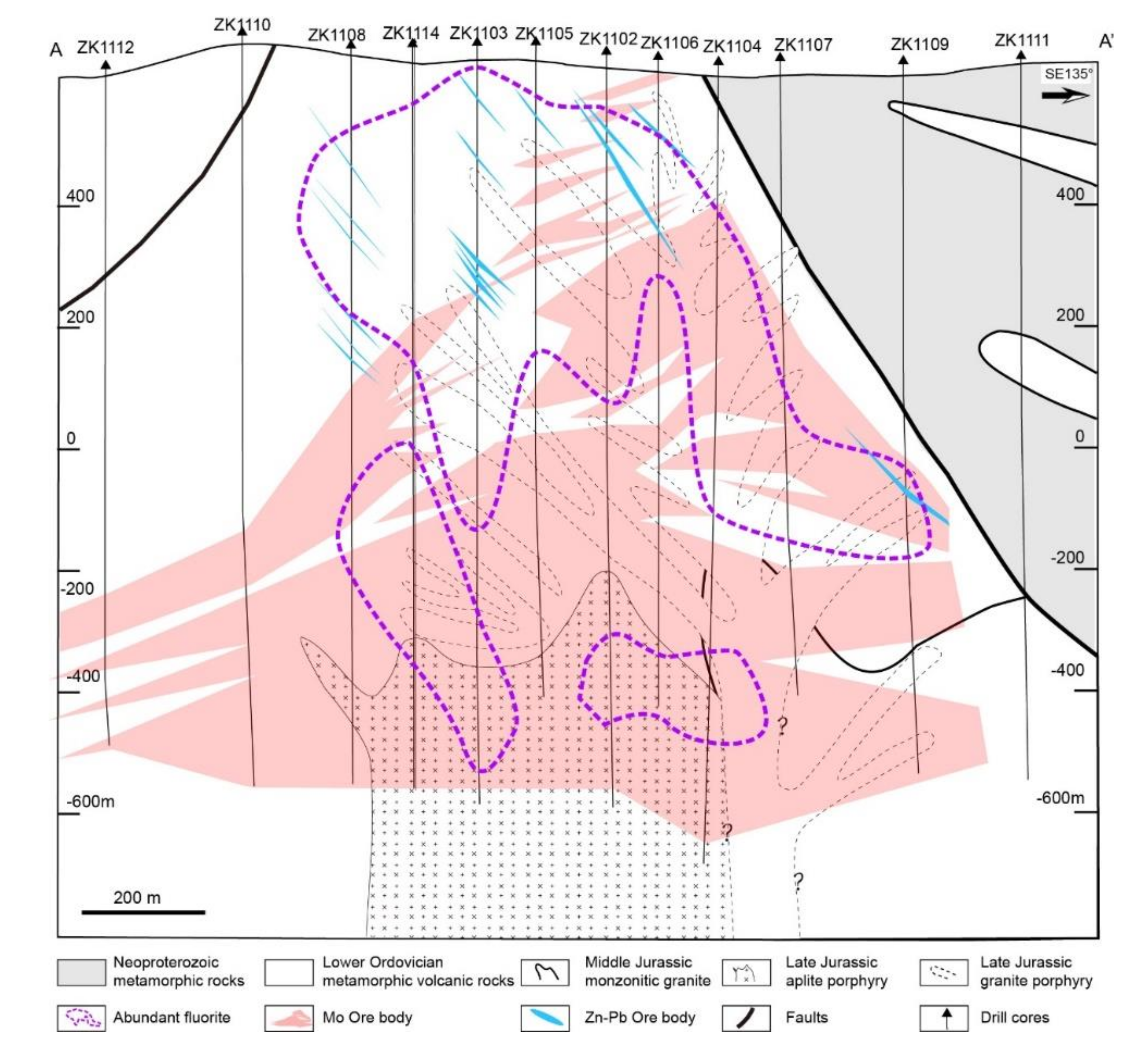
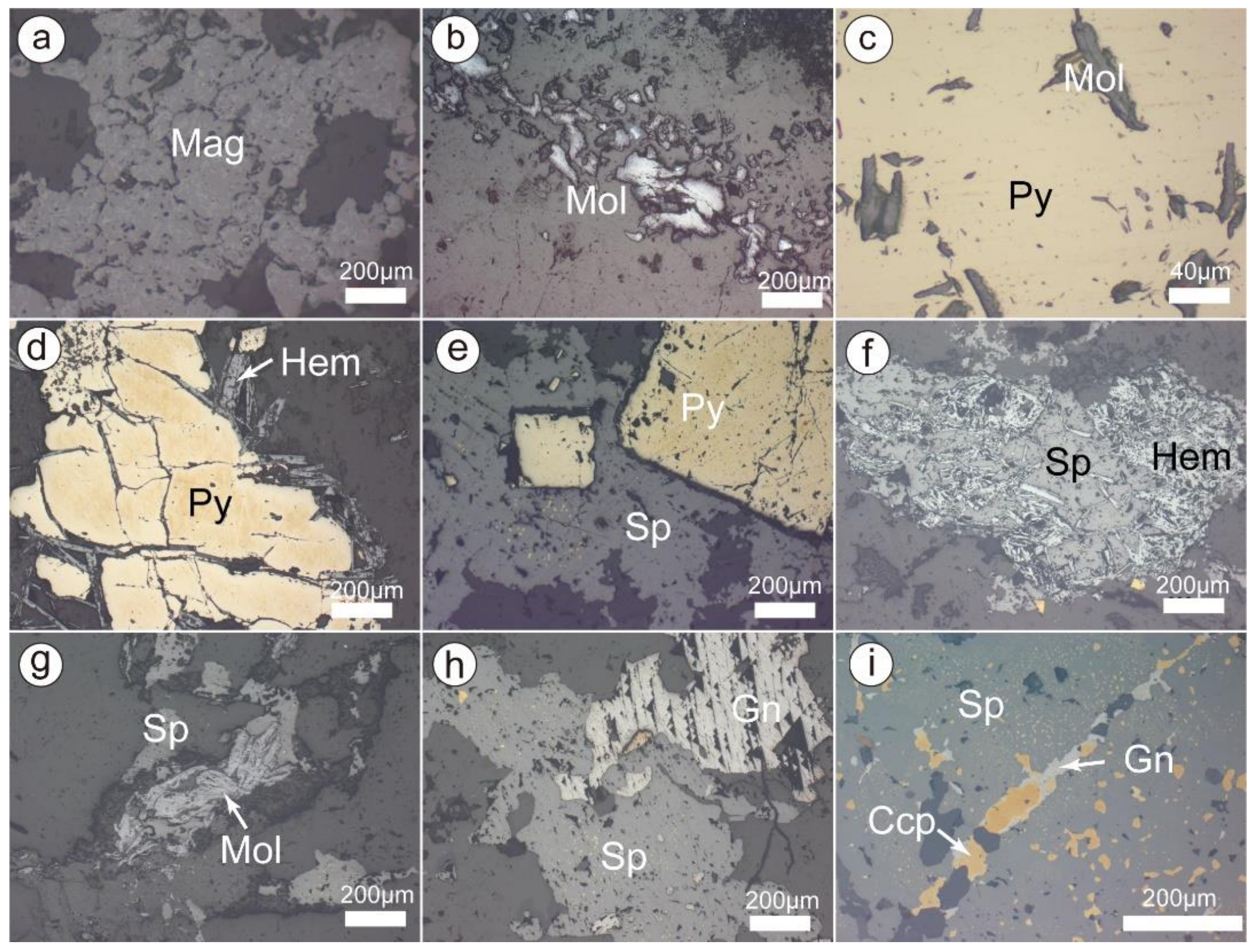
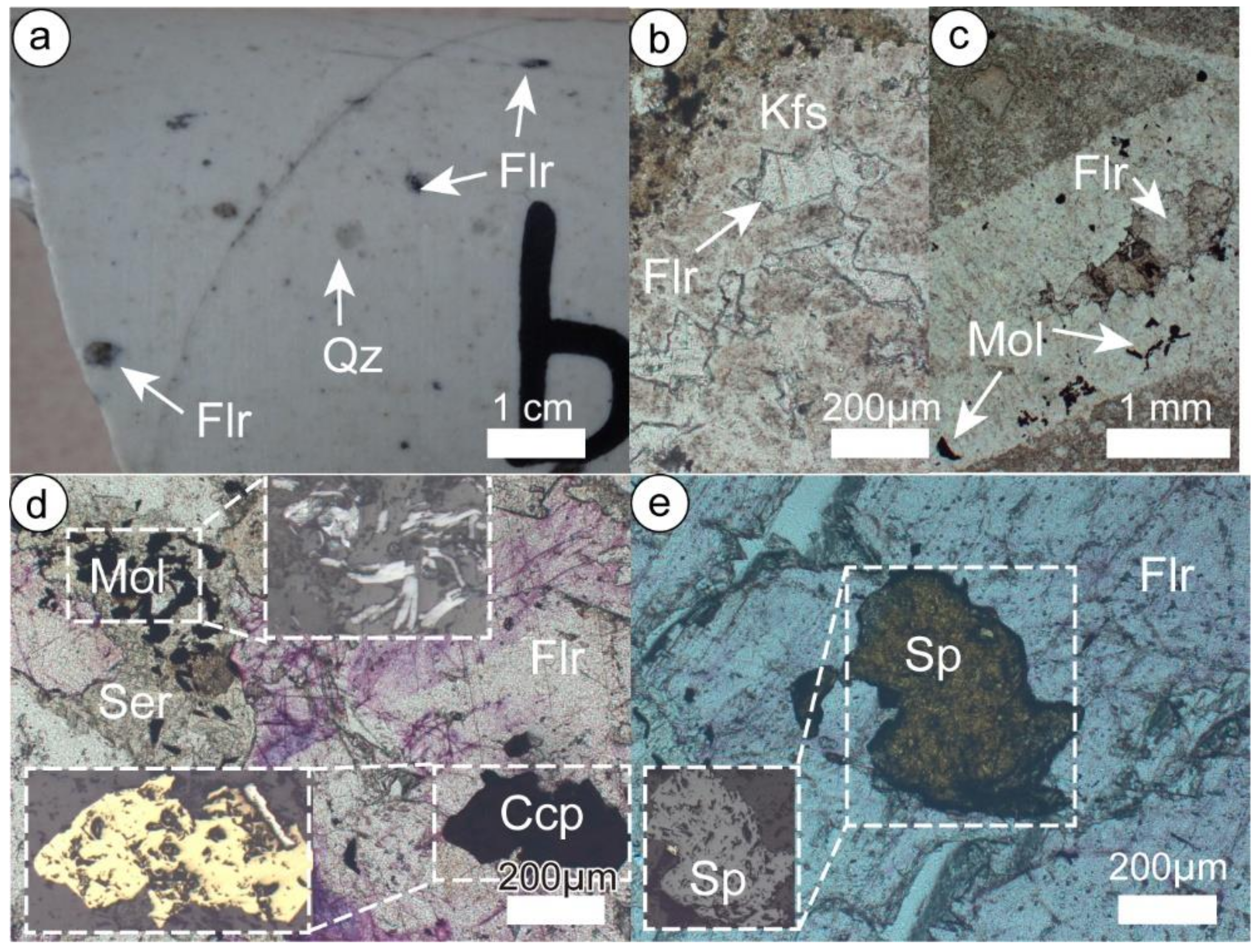
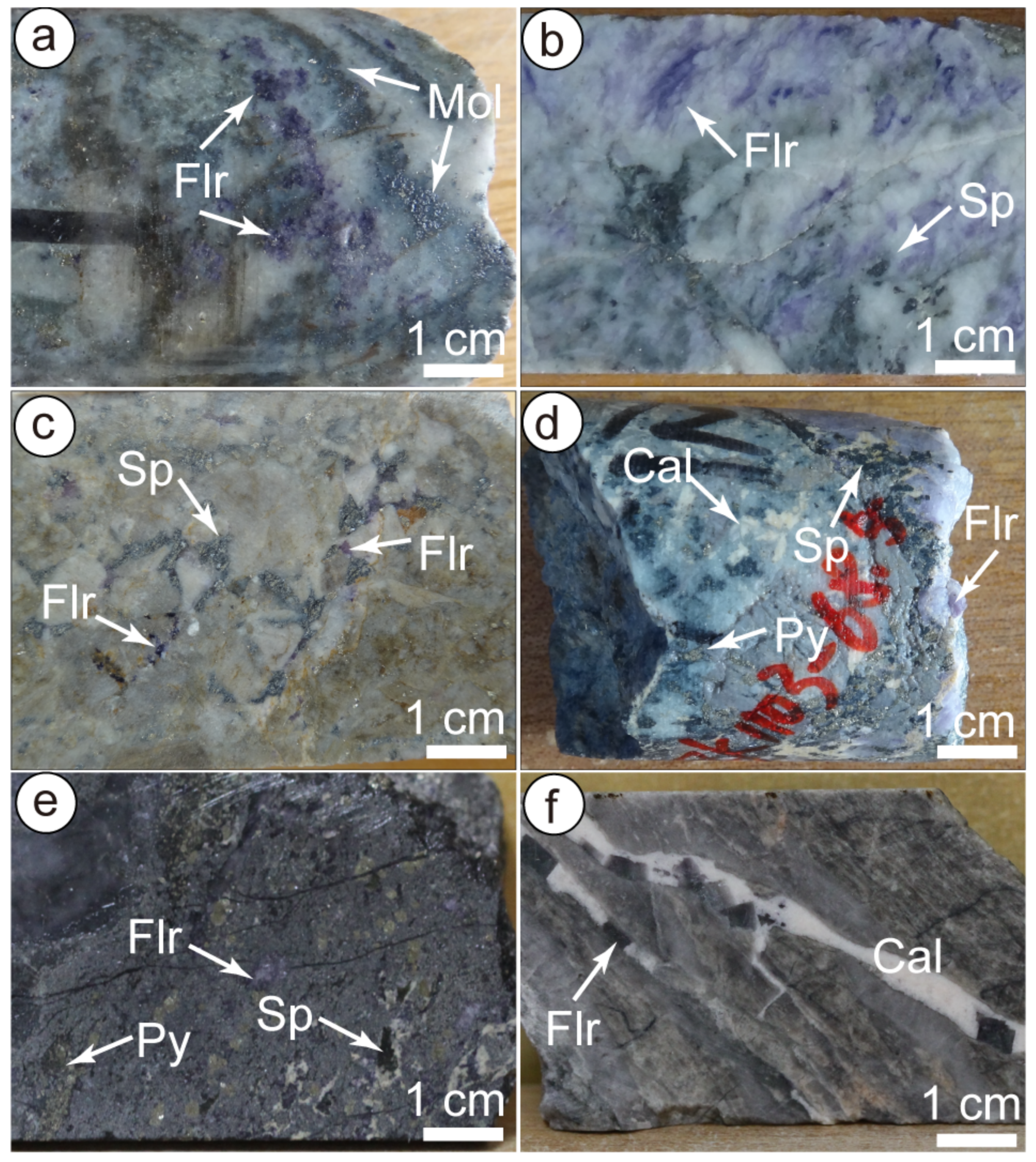
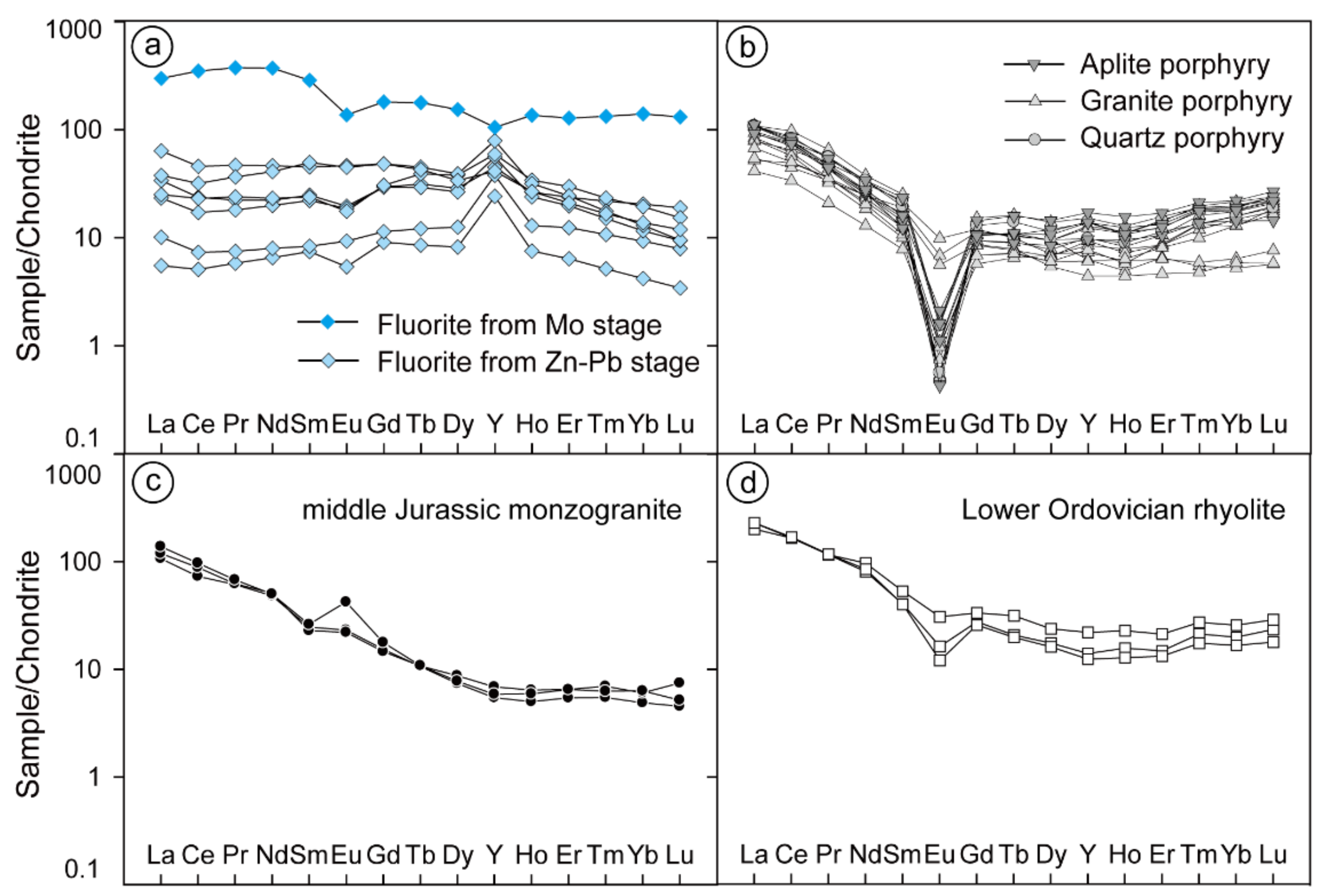
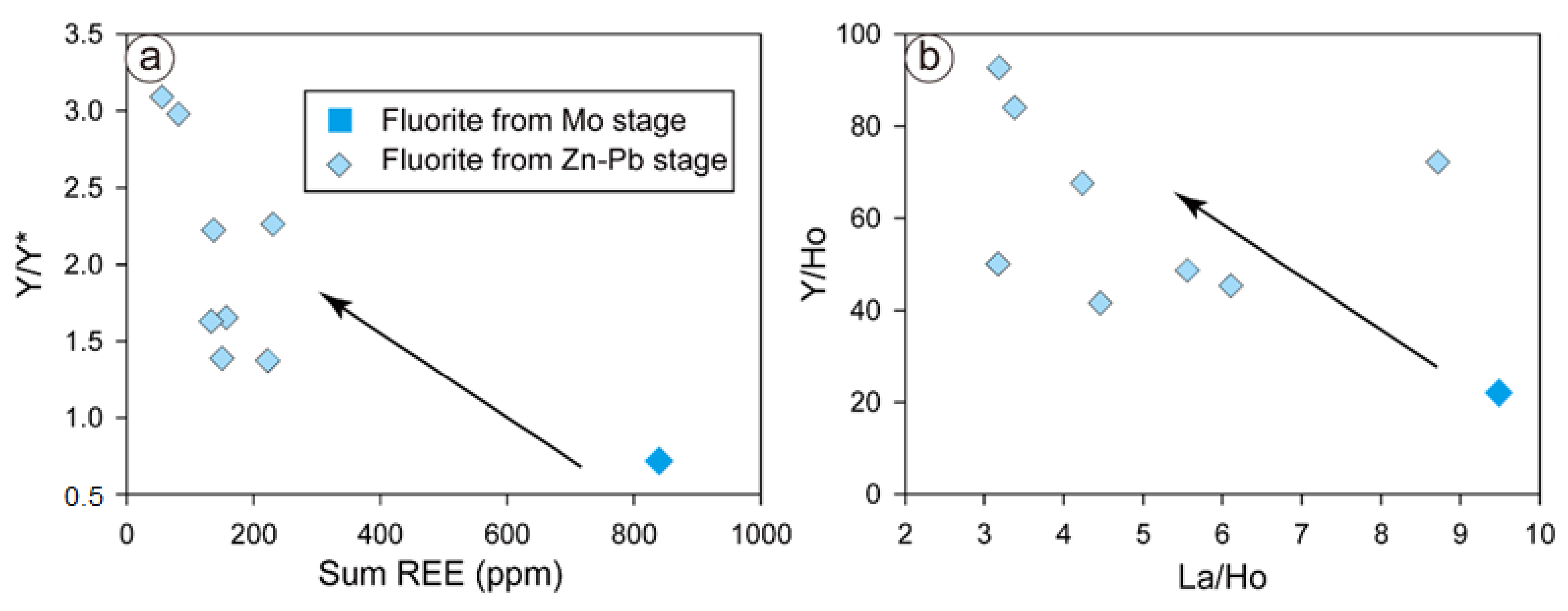
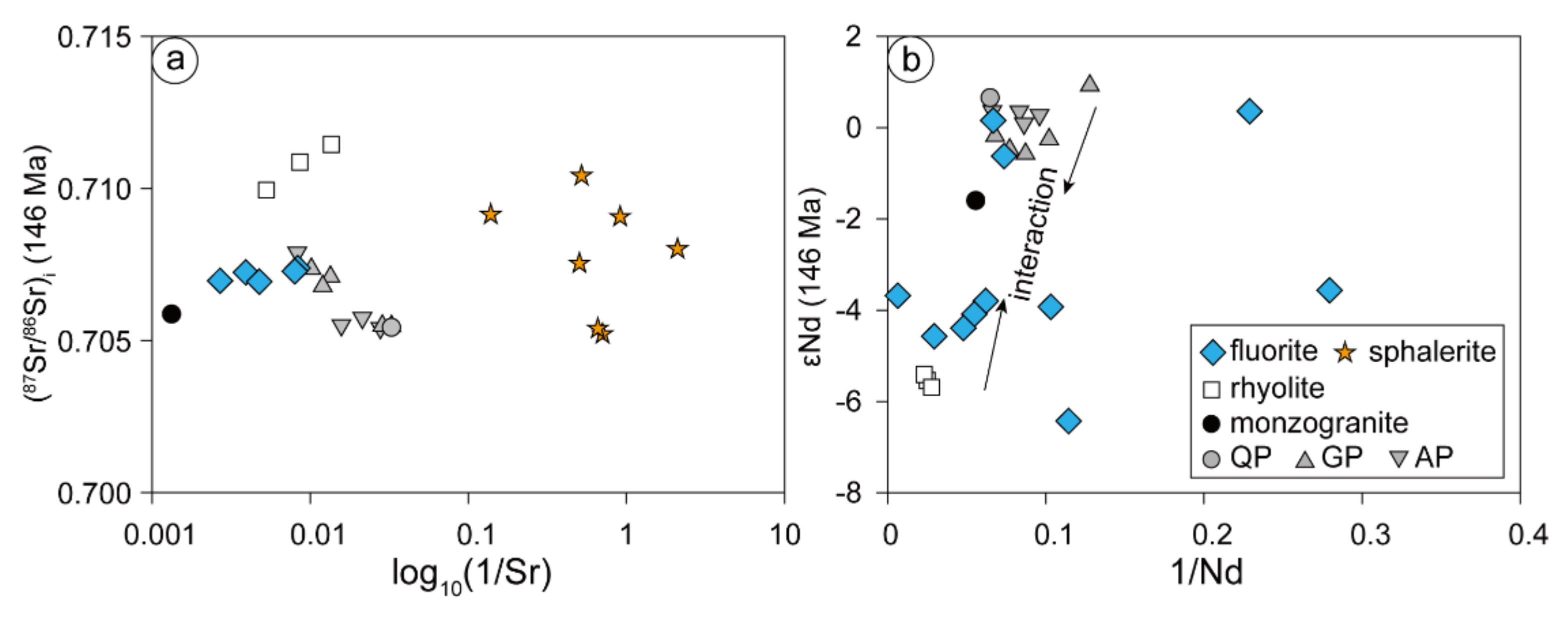
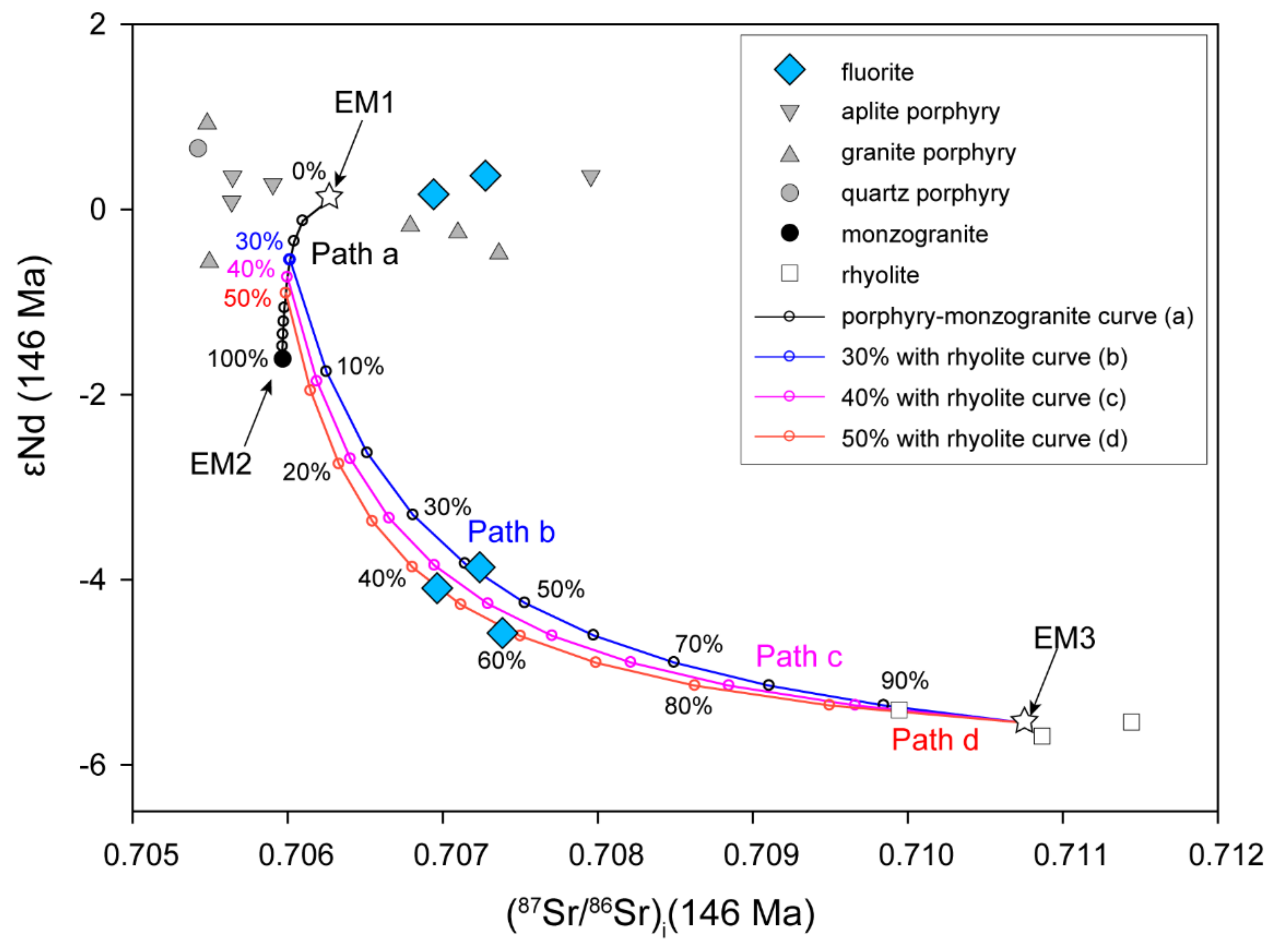
| Sample Number | Host Rocks | Mineralising Stages | Sampling Elevation (m) | Sample Description | Analysis |
|---|---|---|---|---|---|
| Fluorite | |||||
| 1103-736 | Granite porphyry | Mo stage | −103.9 | Qz-Mol-Py-Flr vein, vein width of 20 mm | 1, 3 |
| 1102-347 | Hydrothermal breccia | Zn-Pb stage | 270.5 | Sp-Flr-Py-Cal vein, vein width 80 of mm | 1, 2, 3 |
| 1103-68 | Rhyolite | Zn-Pb stage | 564 | Qz-Sp-Flr-Gn-Py-Cal vein, vein width of 30 mm | 1, 3 |
| 1109-890 | Rhyolite | Zn-Pb stage | −277 | Qz-Sp-Py-Flr vein, vein width of 6 mm | 1, 2, 3 |
| 1711-930 | Rhyolite | Zn-Pb stage | −364 | Qz-Sp-Py-Flr vein, vein width of 15 mm | 1, 3 |
| 804-611 | Rhyolite | Zn-Pb stage | 33.8 | Qz-Flr-Py-Sp-Cal vein, vein width of 15 mm | 1, 3 |
| 808-614 | Rhyolite | Zn-Pb stage | 57 | Cal-Flr vein, vein width of 5 mm | 1, 3 |
| SP-2 | Rhyolite | Zn-Pb stage | - | Sp-Py-Gn-Flr vein, vein width of 30 mm | 1, 2, 3 |
| 1302-269 | Hydrothermal breccia | Zn-Pb stage | 330 | Sp-Py-Flr in cement of hydrothermal breccia | 1 |
| 1606-897 | Hydrothermal breccia | Zn-Pb stage | −314 | Sp-Py-Flr in the cement of hydrothermal breccia | 2, 3 |
| 1104-1162 | Aplite porphyry | Zn-Pb stage | −554 | Flr-Ilt vein, vein width of 30 mm | 2, 3 |
| 804-1029 | Dacite | Zn-Pb stage | −384 | Qz-Flr-Py vein, vein width of 6 mm | 3 |
| Sphalerite | |||||
| SJ-1 | Rhyolite | Mo stage | Mol-Sp-Py-Gn-Cal vein, vein width of 30 mm | 4 | |
| Sp-1 | Rhyolite | Zn-Pb stage | - | Sp-Py-Flr vein, vein width of 20 mm | 4 |
| Sp-10 | Rhyolite | Mo stage | - | Mol-Sp-Py-Gn-Cal vein, vein width of 30 mm | 4 |
| Sp-11 | Rhyolite | Zn-Pb stage | - | Qz-Py-Sp-Gn vein, vein width of 30 mm | 4 |
| Sp-5 | Rhyolite | Zn-Pb stage | - | Sp-Py vein, vein width of 25 mm | 4 |
| 1509-956 | Rhyolite | Zn-Pb stage | −371 | Qz-Sp-Py vein, vein width of 8 mm | 4 |
| 1904-74 | Rhyolite | Zn-Pb stage | 487 | Qz-Sp-Ccp-Gn-Py vein, vein width of 50 mm | 4 |
| Sample Number | 1103-736 | 1102-347 | 1103-68 | 1109-890 | 1711-930 | 804-611 | 808-614 | SP-2 | 1302-269 |
|---|---|---|---|---|---|---|---|---|---|
| Occurrence | Qz–Mol–Py–Flr vein | Sp–Flr–Py–Cal vein | Qz–Sp–Flr–Gn–Py–Cal vein | Qz–Sp–Py–Flr vein | Qz–Sp–Py–Flr vein | Qz–Flr–Py–Sp–cb vein | Cal–Flr vein | Sp–Py–Gn–Flr vein | Sp–Py–Flr in the cement of hydrothermal breccia |
| La | 70.5 | 8.91 | 15.0 | 11.7 | 8.01 | 2.40 | 5.93 | 1.31 | 5.52 |
| Ce | 213 | 19.5 | 28.0 | 24.5 | 14.5 | 4.48 | 14.1 | 3.12 | 10.5 |
| Pr | 34.7 | 3.38 | 4.32 | 4.01 | 2.06 | 0.693 | 2.21 | 0.539 | 1.67 |
| Nd | 169 | 18.7 | 21.2 | 20.7 | 10.1 | 3.63 | 10.6 | 2.99 | 9.08 |
| Sm | 42.2 | 7.33 | 6.69 | 7.53 | 3.65 | 1.23 | 3.52 | 1.10 | 3.26 |
| Eu | 7.71 | 2.52 | 2.60 | 2.05 | 1.10 | 0.523 | 0.985 | 0.303 | 1.05 |
| Gd | 35.9 | 9.54 | 9.59 | 10.7 | 5.84 | 2.26 | 6.07 | 1.80 | 5.86 |
| Tb | 6.39 | 1.54 | 1.62 | 2.09 | 1.13 | 0.436 | 1.40 | 0.308 | 1.05 |
| Dy | 37.8 | 8.31 | 9.56 | 13.2 | 7.06 | 3.08 | 9.33 | 2.01 | 6.52 |
| Y | 164 | 64.7 | 124 | 110 | 70.4 | 59.3 | 92.9 | 37.9 | 87.5 |
| Ho | 7.42 | 1.46 | 1.73 | 2.62 | 1.44 | 0.706 | 1.86 | 0.41 | 1.30 |
| Er | 20.4 | 3.34 | 3.90 | 7.01 | 3.79 | 1.98 | 4.74 | 1.02 | 3.15 |
| Tm | 3.27 | 0.411 | 0.434 | 1.04 | 0.537 | 0.264 | 0.575 | 0.127 | 0.371 |
| Yb | 22.5 | 2.21 | 2.09 | 6.29 | 3.29 | 1.49 | 3.11 | 0.672 | 1.86 |
| Lu | 3.22 | 0.292 | 0.233 | 0.873 | 0.466 | 0.194 | 0.376 | 0.084 | 0.231 |
| (Eu/Eu*)N | 0.60 | 0.92 | 0.99 | 0.70 | 0.72 | 0.95 | 0.65 | 0.66 | 0.73 |
| Y/Ho | 22.14 | 44.35 | 71.75 | 41.81 | 48.87 | 84.06 | 50.00 | 92.51 | 67.22 |
| La/Ho | 9.5 | 6.1 | 8.7 | 4.5 | 5.6 | 3.4 | 3.2 | 3.2 | 4.2 |
| (Y/Y*)N | 0.72 | 1.37 | 2.25 | 1.38 | 1.63 | 2.97 | 1.65 | 3.08 | 2.22 |
| sum-REE | 838.9 | 152.1 | 230.8 | 224.0 | 133.3 | 82.7 | 157.7 | 53.7 | 138.9 |
| Minerals | Sample Number | Occurrence | Rb (ppm) | Sr (ppm) | 87Rb/86Sr | 87Sr/86Sr | Error (2s) | (87Sr/86Sr)i | Sm (ppm) | Nd (ppm) | 147Sm/144Nd | 143Nd/144Nd | Error (2s) | (143Nd/144Nd)i | εNd(t) |
|---|---|---|---|---|---|---|---|---|---|---|---|---|---|---|---|
| Fluorite | 1103-736 | Qz–Mol–Py–Flr vein | 39.42 | 156.6 | 0.1522 | 0.512407 | 0.000007 | 0.512262 | −3.68 | ||||||
| 1102-347 | Sp–Flr–Py–Cal vein | 1.840 | 120 | 0.0444 | 0.707479 | 0.000067 | 0.707386 | 14.03 | 33.91 | 0.2502 | 0.512455 | 0.000010 | 0.512216 | −4.57 | |
| 1103-68 | Qz–Sp–Flr–Gn–Py–Cal vein | 5.993 | 20.88 | 0.1736 | 0.512391 | 0.000014 | 0.512225 | −4.39 | |||||||
| 1109-890 | Qz–Sp–Py–Flr vein | 5.347 | 371 | 0.0417 | 0.707053 | 0.000024 | 0.706966 | 6.865 | 18.25 | 0.2274 | 0.512458 | 0.000010 | 0.512241 | −4.09 | |
| 1711-930 | Qz–Sp–Py–Flr vein | 3.450 | 8.737 | 0.2388 | 0.512349 | 0.000011 | 0.512121 | −6.42 | |||||||
| 804-611 | Qz–Flr–Py–Sp–Cal vein | 1.248 | 3.579 | 0.2108 | 0.512469 | 0.000014 | 0.512268 | −3.56 | |||||||
| 808-614 | Cal–Flr vein | 3.294 | 9.691 | 0.2056 | 0.512445 | 0.000019 | 0.512249 | −3.93 | |||||||
| SP-2 | Sp–Py–Gn–Flr vein | 0.144 | 256 | 0.0016 | 0.707243 | 0.000020 | 0.707239 | 19.36 | 16.15 | 0.7249 | 0.512948 | 0.000013 | 0.512255 | −3.80 | |
| 1606-897 | Sp–Py–Flr in the cement of hydrothermal breccia | 30.21 | 210 | 0.4162 | 0.707812 | 0.000021 | 0.706942 | 3.733 | 14.99 | 0.1506 | 0.512602 | 0.000014 | 0.512458 | 0.16 | |
| 1104-1162 | Flr–Ilt vein | 0.569 | 125 | 0.0131 | 0.707304 | 0.000023 | 0.707277 | 1.108 | 4.371 | 0.1534 | 0.512615 | 0.000016 | 0.512469 | 0.36 | |
| 804-1029 | Qz–Flr–Py vein | 5.098 | 13.59 | 0.2269 | 0.512635 | 0.000080 | 0.512418 | −0.62 | |||||||
| Sphalerite | SJ-1 | Mol–Sp–Py–Gn–Cal | 0.908 | 1.416 | 1.8546 | 0.709096 | 0.000014 | 0.705221 | |||||||
| Sp-1 | Sp–Py–Flr | 0.660 | 1.989 | 0.9598 | 0.709548 | 0.000053 | 0.707542 | ||||||||
| Sp-10 | Mol–Sp–Py–Gn–Cal | 0.265 | 1.096 | 0.6991 | 0.710528 | 0.000013 | 0.709067 | ||||||||
| Sp-11 | Qz–Py–Sp–Gn | 1.320 | 1.518 | 2.5169 | 0.710654 | 0.000013 | 0.705395 | ||||||||
| Sp-5 | Sp–Py | 0.509 | 1.927 | 0.7646 | 0.712015 | 0.000011 | 0.710417 | ||||||||
| 1509-956 | Qz–Sp–Py | 6.813 | 7.236 | 2.7258 | 0.714838 | 0.000020 | 0.709142 | ||||||||
| 1904-74 | Qz–Sp–Ccp–Gn–Py | 0.212 | 0.475 | 1.2936 | 0.710714 | 0.000027 | 0.708011 |
| Endmember (EM) | Rock Type | Sr (ppm) | (87Sr/86Sr)i | Nd (ppm) | εNd(t) | Reference |
|---|---|---|---|---|---|---|
| EM1 | Ore-forming porphyry | 61.96 | 0.706280 | 12.13 | 0.12 | [41] |
| EM2 | monzogranite | 751.93 | 0.705965 | 17.92 | −1.60 | [41] |
| EM3 | rhyolite | 126.46 | 0.710752 | 39.73 | −5.54 | [41] |
Disclaimer/Publisher’s Note: The statements, opinions and data contained in all publications are solely those of the individual author(s) and contributor(s) and not of MDPI and/or the editor(s). MDPI and/or the editor(s) disclaim responsibility for any injury to people or property resulting from any ideas, methods, instructions or products referred to in the content. |
© 2023 by the authors. Licensee MDPI, Basel, Switzerland. This article is an open access article distributed under the terms and conditions of the Creative Commons Attribution (CC BY) license (https://creativecommons.org/licenses/by/4.0/).
Share and Cite
Jin, L.; Qin, K.; Li, G.; Zhao, J.; Li, Z.; Chu, Z.; Song, G. Formation of the Chalukou High Fluorine-Type Mo (–Zn–Pb) Deposit, NE China: Constraints from Fluorite and Sphalerite Rare Earth Elements and Sr–Nd Isotope Compositions. Minerals 2023, 13, 77. https://doi.org/10.3390/min13010077
Jin L, Qin K, Li G, Zhao J, Li Z, Chu Z, Song G. Formation of the Chalukou High Fluorine-Type Mo (–Zn–Pb) Deposit, NE China: Constraints from Fluorite and Sphalerite Rare Earth Elements and Sr–Nd Isotope Compositions. Minerals. 2023; 13(1):77. https://doi.org/10.3390/min13010077
Chicago/Turabian StyleJin, Luying, Kezhang Qin, Guangming Li, Junxing Zhao, Zhenzhen Li, Zhuyin Chu, and Guoxue Song. 2023. "Formation of the Chalukou High Fluorine-Type Mo (–Zn–Pb) Deposit, NE China: Constraints from Fluorite and Sphalerite Rare Earth Elements and Sr–Nd Isotope Compositions" Minerals 13, no. 1: 77. https://doi.org/10.3390/min13010077
APA StyleJin, L., Qin, K., Li, G., Zhao, J., Li, Z., Chu, Z., & Song, G. (2023). Formation of the Chalukou High Fluorine-Type Mo (–Zn–Pb) Deposit, NE China: Constraints from Fluorite and Sphalerite Rare Earth Elements and Sr–Nd Isotope Compositions. Minerals, 13(1), 77. https://doi.org/10.3390/min13010077






